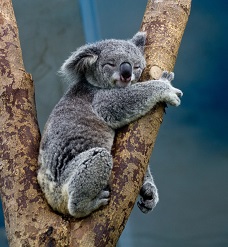Before reading a text, LOOK at its title, any pictures, and other text features.
SKIM over the first paragraph or two, and predict the type and topic of the text.
 The Cuddly Koala
The Cuddly KoalaBecause they resemble teddy bears, they are often referred to as "koala bears." However, koalas are not bears at all. Koalas are marsupials, a special group of "pouched" mammals. Marsupials include kangaroos and wombats, which like the koalas, are native to Australia. Marsupials support their newborn, undeveloped offspring in pouches, or "pockets," on the outside of the mothers’ bodies.
When a "joey"—a baby koala—is born, it is less than an inch long. It has no hair, no ears, and no ability to see. It can smell and feel, though, so it climbs up its mother’s fur and into the pouch on the front of her body. There it stays for about six or seven months, drinking its mother’s milk and growing. When a joey is ready, it comes

Koala with joey |
out of the pouch. It rides on its mother's back for about another six months. Just before the joey is ready to emerge, the mother koala produces a substance called "
pap." Pap contains a special bacteria. The mother feeds it to her joey so that it will be able to digest the only food that koala bears really eat – poisonous eucalyptus

leaves.
. . .
. . .
Koalas spend their entire lives in the eucalyptus forests of eastern Australia. They get all of their nutrients and water from the leaves of the trees. Because eucalyptus trees are poisonous and very tough to digest, koalas have special digestive systems to help them break down and detoxify the leaves. The special bacteria mentioned above is key to koala bears’ ability to digest their food safely. Koalas will sometimes eat a little dirt to help with digestion, too.
Koalas are only able to extract about 25% of the nutrients in eucalyptus leaves. This doesn’t give them a lot of energy for much of anything else but eating. They sleep a lot—up to 20 hours a day! Their bodies have many adaptations that allow them to eat, sleep, and move around easily up high in the branches of the eucalyptus forest.
. . .
As you read, think about what you can
predict based on —
- Text features: pictures, titles, graphs, tables, diagrams, timelines, insets, sidebars, bold and italicized type, pronunciation guides.
- Type of text: informational article, poem, play, story, argumentative text.
- Text structure: cause-effect, problem-solution, compare-contrast, logical order, order of importance, story plot, acts and scenes, rhyme schemes.
| Making predictions will help you understand what you read better. |
❋ ❋ ❋ ❋ ❋ ❋ ❋ ❋ ❋ ❋ ❋ ❋ ❋ ❋ ❋ ❋ ❋ ❋ ❋ ❋ ❋ ❋ ❋ ❋ ❋ ❋ ❋ ❋ ❋ ❋ | Go to the next page to practice making predictions about texts. |


 5th Grade Reading - Making Predictions Lesson
5th Grade Reading - Making Predictions Lesson





 leaves.
leaves.
